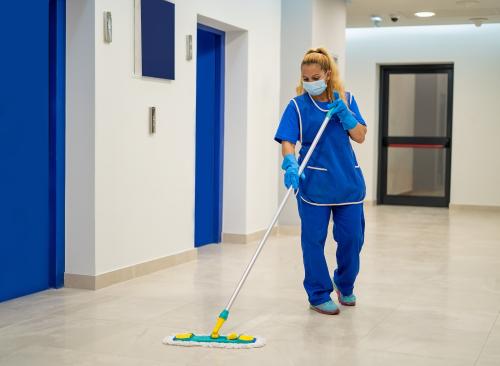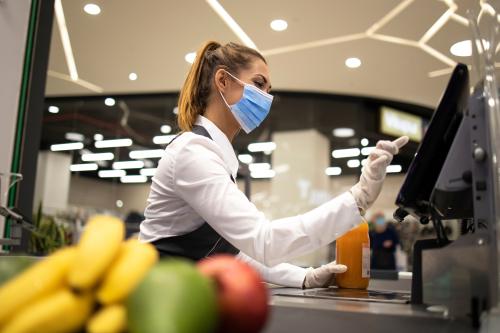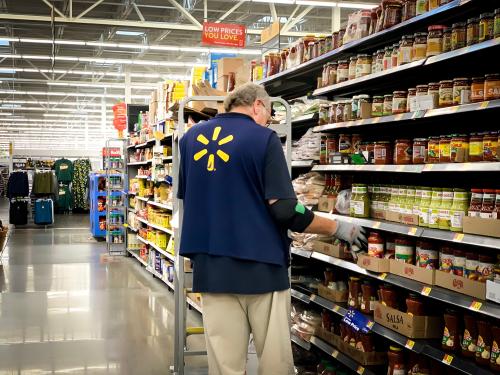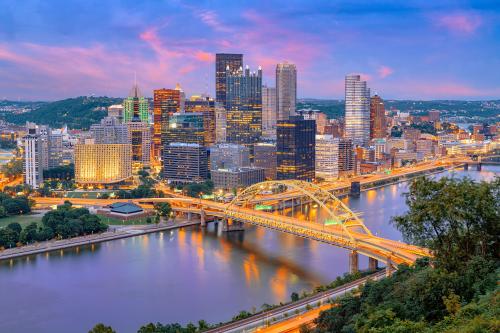Watch the online event Essential workers: One year into the COVID-19 pandemic, held on Thursday, March 18, 2021.
Contents
- Workers with the least are risking the most
- Financial relief and expanded anti-poverty programs are an important start
- A policy manifesto for essential workers
Since the start of the COVID-19 pandemic, political leaders in Washington, D.C. have voiced their enthusiastic commitment to support the country’s essential workers. President Joe Biden, Vice President Kamala Harris, Senate Majority Leader Chuck Schumer (D-N.Y.), and House Speaker Nancy Pelosi (D-Calif.) have each emphasized that it isn’t enough just to praise essential workers—we must pay and protect them as well. But one year into the pandemic, there’s still much work to be done.
Tony Powell is one of the 50 million essential workers who continues to risk his well-being on the COVID-19 frontlines. Powell works as a unit secretary at a hospital in the southeast Washington, D.C. neighborhood where he grew up—a community that COVID-19 has hit hard. In his more than 40 years at the hospital, he has never experienced anything like the pandemic.
“It is a heavy load to carry,” Powell told us in an interview last week. “Sometimes it feels like you are carrying a car up a mountain. You can’t put yourself in a bubble when you see people around you dying. I see people I went to school with and grew up with. They’ll come in and just like that, they are gone. It is really mind blowing that you can be here today and gone tomorrow.”

Powell and his fellow frontline employees at the hospital are strenuously working to do jobs like cleaning, taking vital signs, and spending time with patients—but without the decent pay and respect that nurses and doctors earn. “These are people who work very, very, very hard, and who make very, very, very little,” he said.
With the country on track for mass vaccinations in the coming months, the worst of the pandemic may be over. But the risks facing frontline essential workers like Powell have not ended. Many of the underlining inequities they face—including low wages, structural racism, and inadequate protections—remain.
It is long past time that we treat essential workers as truly essential. Lawmakers in Washington and around the country have the opportunity to turn their policy rhetoric into real change. The recommendations in this report lay out how federal, state, and local policymakers can—finally—give essential workers what they have always deserved: the dignity of a living wage, lifesaving protections, and power in their workplaces.
Workers with the least are risking the most
The COVID-19 pandemic has shone a harsh light on the moral indignity facing millions of essential workers who perform jobs vital to the country at great risk to themselves and their families, but without adequate protections or wages that meet even basic expenses.
From housekeeping to grocery retail to care work, these risky, essential jobs are disproportionately low-paying. Using our colleagues Adie Tomer and Joseph W. Kane’s essential worker classification and 2018 data from the Bureau of Labor Statistics, we found that 22.3 million essential workers were in occupations with a median wage of less than $15 an hour—comprising approximately half (47%) of all workers in these low-wage occupations. Black and brown workers are overrepresented among essential workers in low-wage frontline positions that pose health risks.
Sabrina Hopps, a housekeeping supervisor in an acute care facility in Washington, D.C., worries about the risks her job poses to her family. “I’m petrified, to be honest,” she told us last year. “If I contract it, I live with my son, my daughter, and my granddaughter. My son and I have asthma. He is also a cancer survivor.”


Several studies show that essential workers’ workplace exposure to COVID-19 has resulted in higher rates of contracting the virus, severe illness, and death. Researchers at the University of Pennsylvania determined that essential workers in Pennsylvania had a 55% higher likelihood than nonessential workers of testing positive for COVID-19 during last spring’s shutdown. Cohabitating dependents of essential workers had a 17% higher likelihood of testing positive, while roommates had a 38% higher likelihood. A University of California San Francisco study found that COVID-19 mortality in California has been highest among the state’s frontline essential workers. The mortality risks were especially high in the food and agriculture, manufacturing, facilities, and transportation and logistics sectors, and among Latino or Hispanic, Black, and Asian American workers.
Financial relief and expanded anti-poverty programs are an important start
The American Rescue Plan Act, signed by President Biden last week, provides an important first step in supporting the country’s essential workers. The historic legislation did not specifically target essential workers, and it left out several key priorities such as a higher federal minimum wage and hazard pay. However, the act’s strong equity focus means that low-wage essential workers and their families will receive a disproportionate share of the relief from expanded anti-poverty programs such as the Child Tax Credit and Earned Income Tax Credit, which will slash child poverty and give a one-year income boost for some cashiers, home health aides, cleaners, agriculture workers, and others earning low wages. Stimulus checks will also provide needed financial relief for most essential workers, many of whom carry the double burden of COVID-19 exposure and financial insecurity.
For Yvette Beatty, a home health aide in Philadelphia, the new $1,400 stimulus checks are a lifeline. Throughout the pandemic, she has risked her life caring for some of society’s most vulnerable residents, but has barely made ends meet. Her hours were cut. Her son lost his job and has struggled to access unemployment benefits. Her $12.75 per hour paycheck can’t cover the basic expenses of her family of six, leaving her with painful choices between paying for food and paying her bills. Combined with the $600 from December’s bill, the total of $2,000 in relief would make all the difference.
“It would keep me surviving, so I can keep them surviving,” said Beatty in January, before the new relief bill had passed. “This $2,000 would at least get more food in the refrigerator. It would mean I could catch up on all my bills, buy medicines, pay my mortgage. The $2,000 would help a lot.”
A year into a pandemic in which Americans with the least have sacrificed and struggled the most, the American Rescue Plan Act prioritizes equity and the greatest relief for workers and families with the lowest incomes. But the financial support is temporary, timed to the worst of the pandemic recession. Ultimately, essential workers need permanent change.
A policy manifesto for essential workers
The following seven policy recommendations are aimed at properly paying essential workers, protecting them with adequate health and safety measures, and empowering them to have a greater voice in the workplace.
Paying Essential Workers
When the pandemic shut down nonessential businesses, it was essential workers who kept society functioning. And long after the health risks of the pandemic subside, their work will still be essential. Below are three ways that policymakers can boost pay for essential workers and narrow the enormous gap between the value they bring to society and the extremely low wages many earn in return.
- Raise the federal minimum wage to $15 per hour. The clearest way for federal policymakers to raise essential workers’ wages permanently is to—finally—raise the federal minimum wage to $15 per hour. For too long, the federal minimum wage has been stuck at $7.25 per hour. The wages for essential care workers are so low that nearly 20% of them live in poverty, and more than 40% rely on some form of public assistance; the typical wages for a grocery cashier would put a family of four below the poverty line. A $15 per hour federal minimum wage would disproportionately benefit essential workers such as cashiers, care workers, security guards, warehouse workers, retail staff, nursing assistants, and cleaners. The Economic Policy Institute estimates that a $15 federal minimum wage would lift the pay of 32 million workers, over 60% of whom are essential or frontline workers. While Democrats’ push to include a $15 minimum wage in the American Rescue Plan failed, the Biden administration and Democratic leaders in Congress have pledged continued support for it. Without additional senators’ backing, successful passage of a minimum wage increase may require compromises such as a more gradual increase, a lower hourly raise, regionally adjusted wages, and/or additional support for businesses.
“I think that $15 an hour should be the minimum, and stay there,” Lisa Harris, a Kroger cashier, told us last spring. “We are heroes every day, and we deserve to be paid as such.”

- Make the expanded EITC and Child Tax Credit permanent. The American Rescue Plan includes one-year expansions of two anti-poverty programs that benefit some (but not all) low-wage essential workers: the Earned Income Tax Credit (EITC) and the Child Tax Credit. The expansion of the EITC to childless workers and up to a higher income threshold will boost tax relief next year for millions of essential workers who earn under $21,000 a year, including some cashiers, care workers, cleaners, child care workers, food preparation workers, and agriculture workers. The expanded Child Tax Credit will boost income for millions of low-wage households with children, including some frontline essential workers, and will dramatically cut child poverty. Congress should make these expansions permanent.
- State and local governments should leverage federal funds for temporary hazard pay. Across dozens of interviews, no issue was raised more frequently by frontline essential workers than their desire for hazard pay for the full duration of the pandemic. While the American Rescue Plan did not include dedicated federal funding for hazard pay, it provided $350 billion in generous state and local aid. State and local governments should use this funding to provide hazard pay compensation to low- and modest-wage essential workers. The pay can be retroactive, equity-oriented, and employer-provided. Promising models for this already exist in Pennsylvania, Vermont, Louisiana, Michigan, Virginia, and New Hampshire.
Protecting Essential Workers
Policymakers at the federal and state levels need to take a more proactive role in keeping essential workers safe on the job and providing them the benefits they need to care for themselves and their loved ones. So far, their track record is dismal: As millions of frontline essential workers faced deadly risks over the past year, the federal government failed to adequately protect them. Dire shortages of personal protective equipment (PPE) during the pandemic’s early months jeopardized the safety of millions of essential health workers. The Labor Department’s long-understaffed and underfunded Occupational Safety and Health Administration (OSHA) systematically failed to enforce safety standards during the Trump administration; the agency’s inspector general found that worker complaints to OSHA increased 15% in 2020, but inspections declined by 50%.
A February 2021 survey found that nearly 30% of workers still do not feel protected from contracting COVID-19 at work. Twenty percent of workers reported going into work ill during the pandemic, and two-thirds did so because of a lack of paid sick leave or out of fear of losing a job or angering their employer.
“It’s been a challenge for everybody,” Darryl Cox, a poultry plant worker in Virginia, said in an interview this summer. “We work around 600 people a night in a packed environment. You just have to pray and believe and hope that the person that you’re working next to is not infected.”

- Accelerate efforts to enforce worker safety standards and protect whistleblowers. The Biden administration’s Department of Labor should accelerate efforts to investigate workplace safety concerns. It should also issue an Emergency Temporary Standard requiring employers to create and implement plans to keep workers safe from COVID-19, building on an executive order calling on the Department of Labor to consider such a standard. Congress should also modify OSHA laws to strengthen protection for whistleblowers who file safety complaints.
- State and local governments should prioritize essential workers in vaccine access. In December, the Centers for Disease Control and Prevention issued guidance suggesting frontline essential workers be among the first to be vaccinated. But most states abandoned these guidelines, pushing essential workers back in the queue. As vaccine supply widens, state and local governments should prioritize frontline essential workers. Pennsylvania recently announced that the state will target vaccines to certain frontline essential workers and first responders.
- Expand paid leave. While workers of all incomes are vulnerable to COVID-19, low-wage workers have the least access to paid leave if they (or someone they care for) fall ill. The lack of paid leave puts frontline workers in the position of choosing between their health and their paycheck, or their family members’ care and their job. Last year, Congress passed a limited paid leave program that expired at the end of December. As a replacement, Congress should pass a national, permanent paid leave program to allow essential workers to care for themselves and their loved ones.
Empowering Essential Workers
The pandemic has proven that workers deserve a voice in their workplaces and in the safety decisions that could mean life or death for them. But without a union, workers have little say in employers’ decisions, and little power to shape the conditions of their work. The high-profile firings of workers at Trader Joe’s and Amazon after voicing safety concerns illustrate how nonunionized workers can face retaliation for speaking out.
Several recent studies show how unions are an important vehicle for workers to express workplace safety concerns and negotiate working conditions, in addition to other core issues such as pay and benefits. Researchers at the University of Minnesota found that unionized workers are more likely to speak up about health and safety concerns, and unionized workplaces were 30% more likely to be inspected for a health or safety violation. Another study found that nursing homes with unionized workforces were associated with a 30% reduction in relative COVID-19 mortality rates, largely due to better access to protective equipment.
In an interview last summer, David Saucedo, a 52-year-old nursing home cook in Baltimore and a member of Service Employees International Union, said he was initially denied PPE. Only after he argued his case to two supervisors was he finally able to receive lifesaving protective equipment.
“It gives me a voice,” Saucedo said, on being a member of a union during the pandemic. “It gives me one more ledge before I get pushed over. With the union on our side, I believe I can fight even harder for people.”

According to a 2020 Gallup poll, 65% of Americans approve of labor unions—the highest level since 2003. But after decades of declining union participation, only about 10% of American workers belong to one. Current labor laws make it extremely difficult for workers to unionize. Amazon’s aggressive anti-union response toward organizing efforts by warehouse workers in Bessemer, Ala. illustrates these daunting challenges.
- Strengthen labor laws to enable more worker representation and collective bargaining. Congress should reform decades-old labor laws to allow many more workers to access the protection of unions and representation. Last week, the White House issued a statement backing the Protecting the Right to Organize (PRO) Act. The legislation would enable more workers to form a union, gain collective bargaining rights, exert greater power in disputes, and exercise their right to strike, while curbing employers’ retaliation and interference. The PRO Act passed in the House of Representatives last week but faces long odds in the Senate due to strong Republican opposition.
Since the start of the COVID-19 pandemic a year ago, dozens of frontline essential workers have shared with us their pandemic experiences, the challenges they are confronting, and their hopes for the future. Many said that while it should not have taken a pandemic to make their work visible and valued, it has shown that change is urgently needed.
Lisa Harris, a Kroger cashier outside of Richmond, Va., reflected on this opportunity for change.
“Someone once said, ‘You are a fool if you don’t use a crisis,’” Harris said. “This is a crisis for our country, and we need to think about how we can use it to be better after we come through this.”
For Harris, that starts with valuing essential workers and compensating them fairly.
“We haven’t gone from unskilled labor to essential personnel. We always were essential personnel.”








